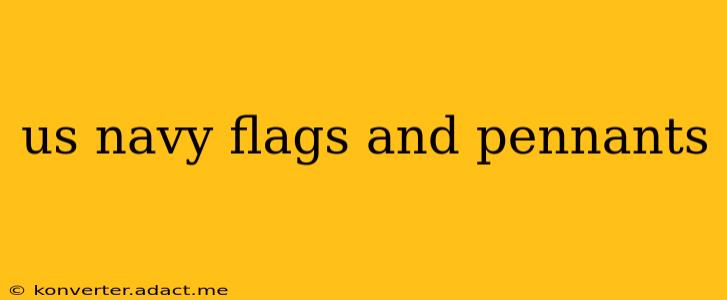The United States Navy utilizes a complex system of flags and pennants for communication, identification, and ceremonial purposes. Understanding these signals is crucial for both naval personnel and enthusiasts interested in maritime history and protocol. This guide delves into the various types of flags and pennants used by the US Navy, explaining their meanings and significance.
What are the different types of US Navy flags?
The US Navy employs a wide array of flags and pennants, each serving a specific function. These can be broadly categorized into:
-
National Flags: These represent the United States itself, most notably the national ensign (the American flag) which is flown by all US Navy ships.
-
Command Flags: These indicate the rank and authority of a commanding officer. These flags are flown from the main mast or a designated location on a ship. The most prominent examples include those for the Admiral, Vice Admiral, and Rear Admiral.
-
Specialty Flags (also known as signal flags): Used for communication between ships, these flags are part of the International Code of Signals, supplemented by Navy-specific signals. These signals can convey messages ranging from simple instructions to complex tactical commands.
-
Pennants: These are long, narrow flags often used to denote a ship's status, such as whether it's in commission, or to indicate a specific function or unit. Some pennants might signify a ship's affiliation with a particular fleet or squadron.
-
Ceremonial Flags: These flags are used during formal events, parades, or other official ceremonies.
What do the different Navy flags mean?
The meaning of a Navy flag is heavily context-dependent. A simple flag like the US national ensign displays national identity, whereas a command flag indicates the presence and rank of a senior officer. The International Code of Signals allows for complex communication through combinations of flags. Each flag within that code has a specific letter or numeral association. Therefore, the meaning of a single flag isn't easily summarized without knowing its context within the larger system.
Some examples of command flags include the Admiral's flag (a four-star flag representing the highest naval rank) and other variations for Vice Admirals and Rear Admirals (represented by three-star and two-star flags respectively).
How are US Navy flags used for communication?
The primary method of communication using flags is through the International Code of Signals (ICS). Each pennant or flag represents a letter or number; by hoisting multiple flags in a specific sequence, complex messages can be conveyed, detailing anything from weather conditions to urgent requests for assistance. The Navy uses this code in conjunction with its own internal signals to ensure clear and effective communication across distances.
What are some of the most common US Navy pennants?
While a comprehensive list would be extensive, some common pennants include those identifying a ship's commissioning status (indicating an active ship vs. one in reserve), and those that indicate squadron affiliation. Specific designs and meanings often evolve and may not be publicly available due to operational security considerations.
What are the different sizes of US Navy flags?
The size of a Navy flag varies greatly depending on its purpose and the location where it is displayed. Larger flags are used on major warships and during formal ceremonies, while smaller versions might be seen on smaller vessels or in offices.
Where can I find more information on US Navy flags and pennants?
Further information can often be found through dedicated naval history resources and websites focused on maritime signaling. Many specialized books delve deeply into the history and usage of specific flags and pennants. However, details on current operational signals may be restricted for security reasons.
This guide provides a foundational understanding of US Navy flags and pennants. The complexity of the system necessitates further research for a complete grasp of the nuanced meanings and applications of these important maritime symbols.
